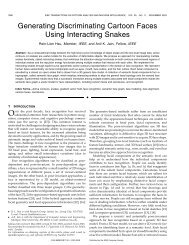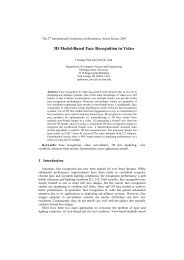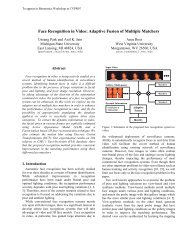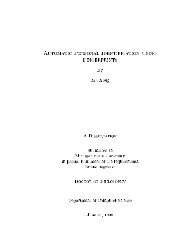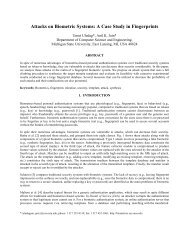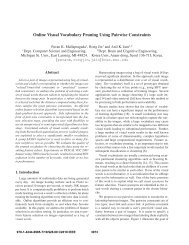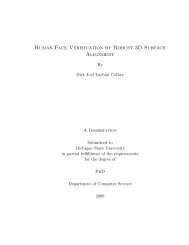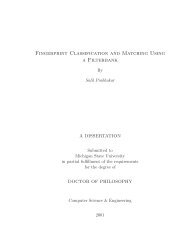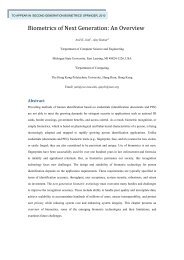Face Detection and Modeling for Recognition - Biometrics Research ...
Face Detection and Modeling for Recognition - Biometrics Research ...
Face Detection and Modeling for Recognition - Biometrics Research ...
Create successful ePaper yourself
Turn your PDF publications into a flip-book with our unique Google optimized e-Paper software.
center, <strong>and</strong> lengths of major <strong>and</strong> minor axes. Since we know the locations of eyes <strong>and</strong><br />
mouth, the orientation of the ellipse can be estimated from the direction of a vector<br />
that starts from the midpoint between the eyes towards the mouth. The location of<br />
the ellipse center is estimated from the face boundary map. Hence, we need only a<br />
two-dimensional accumulator <strong>for</strong> estimating the ellipse <strong>for</strong> bounding the face. The<br />
accumulator is updated by perturbing the estimated center by a few pixels <strong>for</strong> a more<br />
accurate localization of the ellipse.<br />
3.3.5 Weight Selection <strong>for</strong> a <strong>Face</strong> C<strong>and</strong>idate<br />
For each face in the image, our algorithm can detect several eye-mouth-triangle c<strong>and</strong>idates<br />
that are constructed from eye <strong>and</strong> mouth c<strong>and</strong>idates. Each c<strong>and</strong>idate is assigned<br />
a weight which is computed from the eye <strong>and</strong> mouth maps, the maximum accumulator<br />
count in the Hough trans<strong>for</strong>m <strong>for</strong> ellipse fitting, <strong>and</strong> face orientation that favors<br />
vertical faces <strong>and</strong> symmetric facial geometry, as described in Eqs. (3.15)-(3.19). The<br />
eye-mouth triangle with the highest weight (face score) that is above a threshold is<br />
retained. In Eq. (3.15), the triangle weight, tw(i, j, k), <strong>for</strong> the i-th <strong>and</strong> the j-th eye<br />
c<strong>and</strong>idates <strong>and</strong> the k-th mouth c<strong>and</strong>idate is the product of the eye-mouth weight,<br />
emw(i, j, k), the face-orientation weight, ow(i, j, k), <strong>and</strong> boundary quality, q(i, j, k).<br />
The eye-mouth weight is the average of the eye-pair weight, ew(i, j), <strong>and</strong> the mouth<br />
weight, mw(k), as described in Eq. (3.16).<br />
79



